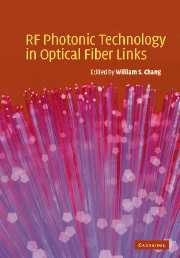Book contents
- Frontmatter
- Contents
- List of contributors
- Introduction and preface
- 1 Figures of merit and performance analysis of photonic microwave links
- 2 RF subcarrier links in local access networks
- 3 Analog modulation of semiconductor lasers
- 4 LiNbO3 external modulators and their use in high performance analog links
- 5 Broadband traveling wave modulators in LiNb03
- 6 Multiple quantum well electroabsorption modulators for RF photonic links
- 7 Polymer modulators for RF photonics
- 8 Photodiodes for high performance analog links
- 9 Opto-electronic oscillators
- 10 Photonic link techniques for microwave frequency conversion
- 11 Antenna-coupled millimeter-wave electro-optical modulators
- 12 System design and performance of wideband photonic phased array antennas
- Index
- References
7 - Polymer modulators for RF photonics
Published online by Cambridge University Press: 06 July 2010
- Frontmatter
- Contents
- List of contributors
- Introduction and preface
- 1 Figures of merit and performance analysis of photonic microwave links
- 2 RF subcarrier links in local access networks
- 3 Analog modulation of semiconductor lasers
- 4 LiNbO3 external modulators and their use in high performance analog links
- 5 Broadband traveling wave modulators in LiNb03
- 6 Multiple quantum well electroabsorption modulators for RF photonic links
- 7 Polymer modulators for RF photonics
- 8 Photodiodes for high performance analog links
- 9 Opto-electronic oscillators
- 10 Photonic link techniques for microwave frequency conversion
- 11 Antenna-coupled millimeter-wave electro-optical modulators
- 12 System design and performance of wideband photonic phased array antennas
- Index
- References
Summary
Benefits of polymer modulators
Polymer electro-optic modulators offer several important advantages over more mature technologies such as lithium niobate interferometric modulators or semiconductor electroabsorption modulators. Velocity matching between RF and optical waves is much simpler because there is a close match between the dielectric constants at optical and radio frequencies, enabling flat response to higher frequencies. The relatively low dielectric constant enables 50-Ωdrive electrodes to be easily achieved with simultaneous velocity matching. Sensitivity as much as an order of magnitude greater than in lithium niobate may be achievable, primarily through material engineering to achieve very large electro-optic coefficients, but also through the drive field concentration enabled by parallel-plate or microstrip drive electrodes. Greater sensitivity can result in greater RF gain and smaller noise figure of an RF link incorporating an external modulator. While the electro-optic effect employed is resonant, the wavelength of operation is far from resonance, so that there is little wavelength sensitivity or thermal sensitivity, in contrast to electroabsorption modulators which are operated close to resonance. The refractive index of polymer materials is nearly matched to that of glass optical fibers, enabling small Fresnel losses at interfaces. The material cost of polymer modulators may be low because they can be made of thin films of high-value polymer material on top of inexpensive substrates. Because polymer waveguide layers can be fabricated on a variety of substrates, including flexible substrates, by spin-coating, integration of polymer waveguides with other components is possible, and conformable devices could be made.
- Type
- Chapter
- Information
- RF Photonic Technology in Optical Fiber Links , pp. 203 - 230Publisher: Cambridge University PressPrint publication year: 2002
References
- 2
- Cited by



